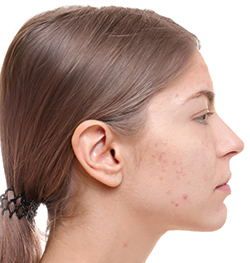Teenagers just came out of childhood where they were mostly catered for by their parents and did not have to worry about much. Teenagers are overworked and changes in their circadian rhythm makes them feel constantly tired an irritable. Add to that the fact that they now have to worry about having good skin and developing a skin care routine and it is no wonder many teenagers seem irritable. Transitioning from washing one’s face with water and some soap to a full routine can be a challenge. So, it is understandable that they can get frustrated at finding easy solutions to their skin problems.
 HORMONES
HORMONES
In puberty, hormones become very active. Teenage bodies start producing androgen, which causes their bodies to develop.
Androgens are group of hormones primarily influencing the growth and development of the male reproductive system. The predominant and most active androgen is testosterone. The other androgens, which support the functions of testosterone, are produced mainly by the adrenal cortex in relatively small quantities.
In boys, androgens are needed for the development of the male reproductive system. Males tend to produce more androgen than females.
Teenage girls produce about one-twelfth as much androgen as teenage boys. Androgens are essential precursors of estrogens and no estrogens can be produced without them.
Unfortunately, the hormone levels during puberty can vary greatly in the body, which causes the skin to naturally breakout.
ADOLESCENCE AND ACNE
Statistics show that eight in 10 teenagers suffer from acne. Many of them have regular breakouts and some can have severe acne which, if left untreated, can lead to scarring and a lifetime of emotional issues. Most teenagers that visit a professional will do so with a parent and their number one concern is typically acne. Teenagers are often busy with school and activities and tend to prefer simple solutions to their skin problems. The skin care professional and the parents are key players in helping teenagers have clear skin.
The acne-causing bacteria known as propionibacterium acnes lives in the human body and is present in the sebum secreted by the sebaceous glands, which are connected to the hair follicles. The sebum is naturally produced by the glands to help moisturize the skin. A teenager’s skin renews itself every seven to 10 days and, to do that, the skin needs to expel dead cells to make space for new skin.
When the androgen hormone becomes unbalanced, it causes the oil-producing glands to be overstimulated, which causes the dead cells to be stickier and clog the hair follicles more than normal. Androgens can also cause an overproduction of P acnes. This overstimulation of oil, dead cells, and bacteria leads to acne problems.
MISDIAGNOSIS
It is important for the professional to make sure that what they are looking at is truly acne and not something else. The professional should also keep in mind that severe acne cases should be referred to a dermatologist. Severe stage three acne can only be cured by doctor-prescribed medication and the professional should be able to develop a relationship with a dermatologist where referrals can be mutually beneficial.
That being said, when a new client is in the treatment room, it is important to recognize their skin issues because several skin diseases have common symptoms and acne has become a universal term for many skin conditions. Also, keep in mind that multiple skin conditions can be present all at once on the teenager’s skin.
Rosacea
Rosacea, which affects millions of people, is often mistaken for acne. Rosacea concentrates mainly in the nose and middle area. Although rosacea affects more adults then teenagers, teenagers can have rosacea, as well. Rosacea is characterized by facial redness and flushing, which means the skin may be red on the cheeks. If rosacea is advanced, teenagers may also have small papules and white bumps without pus. Acne blemishes are a deeper shade of red and, in teenagers, lesions are often filled with oil or bacteria-causing pus. Teenagers also have pimples, white heads, and blackheads.
Keratosis Pilaris
Keratosis pilaris is mostly hereditary and is caused by the accumulation of keratin in the hair follicles, which in turn causes rough bumpy white pimples that look just like mild acne. Keratosis pilaris occurs more on the cheeks, upper arms, thighs, and legs and is not caused by P acnes. There has been an increase of keratosis pilaris in teenagers recently and the professional should learn to tell the difference.
Perioral Dermatitis
Perioral dermatitis causes the accumulation of pimples around the mouth in a circular shape. This little-known condition is thought to be caused by the use or overuse of topical and inhaled steroids. So, a teenager with asthma may develop perioral dermatitis. Although rare, certain food additives in chewing gums have also been blamed for this chronic, inflammatory type condition.
 BEHIND THE BREAKOUT
BEHIND THE BREAKOUT
There are many triggers that can contribute to breakout. The following are a few of the most common triggers associated with breakouts.
Oily Skin
Sebum is food for the P acnes bacteria, so, sometimes, teenagers with more oily skin tend to have more acne-prone skin, but this is not always the case and a lot of cleansers that are currently on the market are too harsh for teenage skin. The “squeaky clean skin feel” is actually the opposite of what any teenager should do. Stripping too much oil from the skin will cause the sebaceous glands to overproduce oil, which in turn aggravates the acne problem.
Sweating
Friction and sweating can cause the proliferation of bacteria on the skin surface, which, in combination with oil, creates the perfect environment for acne breakouts, particularly in the back. Teenagers who are involved in sports should be told to remove the sweat as quickly as possible, so that it does not trap the bacteria that causes acne.
Diet
Much is said about diet not causing the proliferation of bacteria, however, recent findings are pointing to the “leaky gut syndrome” as the main reason acne is on the rise in adults. North American diets contain a lot of processed foods and these foods often contain emulsifiers and other products that can disrupt the gut balance.
P acnes lives in the gut and if a teenager’s diet is mainly composed of store-prepared and processed food, there is a real chance that the flora in the gut will be a main factor in the multiplication and proliferation of the acne bacteria. Diet and nutrition are sensitive subjects, but eating things like probiotics can help improve the gut health and may provide some relief for the skin, as well.
Social Media
The advent of social media and selfies has created more pressure on teenagers because they see perfect skin and perfect makeup, which is often airbrushed and an unrealistic ideal to attain. Current makeup trends often involve makeup artists applying an enormous amount of product to the face and that leads to clogged pores. Most teenagers also do not wash their faces before going to bed, which can aggravate acne and breakouts.
TEENS AND SUNSCREENS
Recent data from the Department of Health and Human Services shows that about 13 percent of girls and seven percent of teenage boys apply sunscreens regularly. This disturbing statistic also means that many teenagers will be at risk of developing skin cancers and melanoma, which have both been on the rise in recent years.
According to the American Cancer Society and the American Academy of Dermatology, correct and regular use of an SPF 15 or higher sunscreen prevents sunburn and reduces the risk of non-melanoma cancers by 40 percent and, more importantly, melanoma cancers by 50 percent. The professional should stress the importance of using sunscreen regularly.
Physical Sunscreens
Formulated only with the inorganic ingredients zinc oxide and titanium dioxide, they are designed to block the photons from penetrating the skin. Sunscreens protect from both UVA and UVB rays and they are stable and will not break down under the sun. In the past, these formulas had their limitations because they would give the skin a chalky unappealing look, however, the recent advent in micronized ingredients have allowed the newer formulas to be silkier and to blend in better and avoid the whitening or chalky look.
Chemical Sunscreens
These are made of organic compounds and contain a larger family including avobenzone and oxybenzone. To protect from both UVA and UVB rays, a blend is needed in the formula to provide broad-spectrum capabilities. Sunscreens should be used on top of a good daily moisturizer because a lot of sunscreen products do not provide enough moisturizing ingredients and should be worn as a second layer.
THE TEEN FACIAL
It is a good idea for any spa to have an acne facial as a part of their menu. Not only do teenagers have acne issues, but adults do, as well. Therefore, it is important to have an acne-specific treatment available, as well as acne-specific skin care products. If the professional does not have a specific facial to treat acne, then they should reach out to their product manufacturer to help them develop a specific routine with gentle products.
One thing to remember is that acne-prone skin should be treated the same way as sensitive skin.
Medical Devices
Blue LEDs should be used regularly when treating an acne-prone teenager. The idea is that at a certain frequency, typically 435 to 500 µm, the light will destroy bacteria and soothe inflammation. If an acne-specific facial is offered at the spa, why not incorporate blue LED? LED devices should be added to any teenage facial as it can only help to enhance the treatment.
HOMECARE ROUTINE
The professional should give teenage clients tips to manage their skin at home. This will also, in return, help the professional improve the client’s trust and they will become even more loyal.
Stress to the parent and to the teenager the importance of following a specific routine and doing it every morning and evening. Instruct the teenager to wash the face twice a day using a mild cleanser or a cleanser containing salicylic acid. If using a toner, recommend ones with witch hazel and no alcohol to help control oil production. Teenagers should keep the skin well hydrated by using a good and simple moisturizer daily and use an SPF 15 or more sunscreen every morning to help prevent sunburns. They should use skin care products containing ingredients such as salicylic, retinoic, or glycolic acid to help reduce bacterial propagation and skin inflammation and avoid harsh scrubs like sugar and salt scrubs. Remind them not to overuse makeup and layer too many products, as this swill cause the skin to clog. They should remove sweat that can cause acne flareups, not allowing it to sit on the skin, wash the hands regularly in order to avoid spreading bacteria over the skin, and avoid touching the face with the hands or handling pimples, which spreads bacteria. Teenagers should also be educated on drinking plenty of water and avoiding sodas and processed foods in excess; instead, they should look for probiotics in foods.
Teenagers are now savvy and have access to a lot of information, so educate them and teach them to look for solutions that will help them maintain clear and problem-free skin.
Teenage skin can be difficult to understand as it is constantly changing due to active hormones. However, being knowledgeable about causes of acne and breakouts, having teenage-specific menu items, and recommending proper homecare can make all the difference and help garner trust in clients and their parents, leading to overall client satisfaction and loyalty.
The Quick Test
Here are some questions the professional can use in order to help the teenager gain confidence and also recommend the most appropriate homecare routine.
- Tell me about your skin care routine.
- How often do you wash your face?
- Do you use any scrubs to exfoliate your skin?
- Do you remove makeup and wash your face before going to bed?
- When did you last change your skin care routine?
- What products do you use on your skin?
- Do you notice redness or itchiness after using certain products?
- Do you talk with your hands a lot?
- Are you constantly rubbing and touching your face with your hands?
- Did you change your hair products recently?
- Do you use a lot of hairspray?
- Anything new in your skin care routine?
- Tell me about your diet.
 Christiane Waldron is the founder and CEO of Jenetiqa, a professional luxury skin care company focused on providing highly bio-available skin care products that combine scientifically-proven antioxidants with natural botanicals and skin vitamins. Waldron is a chemical engineer by profession and she is the chief scientist for Jenetiqa. She personally hand picks each ingredient in the formula. Waldron’s philosophy is to design and formulate multi-tasking products that help address all signs of aging. Jenetiqa is her brain child and she developed a best-selling anti-aging system that is unique in that it provides 4 treatment products into a simple to use system. Waldron also developed a professional line that caters to the spa industry. She is a strong believer in a 360-degree approach to skin care and giving the skin all the food it needs to stay healthy. Her philosophy focuses on education, early prevention, and an excellent daily routine.
Christiane Waldron is the founder and CEO of Jenetiqa, a professional luxury skin care company focused on providing highly bio-available skin care products that combine scientifically-proven antioxidants with natural botanicals and skin vitamins. Waldron is a chemical engineer by profession and she is the chief scientist for Jenetiqa. She personally hand picks each ingredient in the formula. Waldron’s philosophy is to design and formulate multi-tasking products that help address all signs of aging. Jenetiqa is her brain child and she developed a best-selling anti-aging system that is unique in that it provides 4 treatment products into a simple to use system. Waldron also developed a professional line that caters to the spa industry. She is a strong believer in a 360-degree approach to skin care and giving the skin all the food it needs to stay healthy. Her philosophy focuses on education, early prevention, and an excellent daily routine.
Want to read more?
Subscribe to one of our monthly plans to continue reading this article.